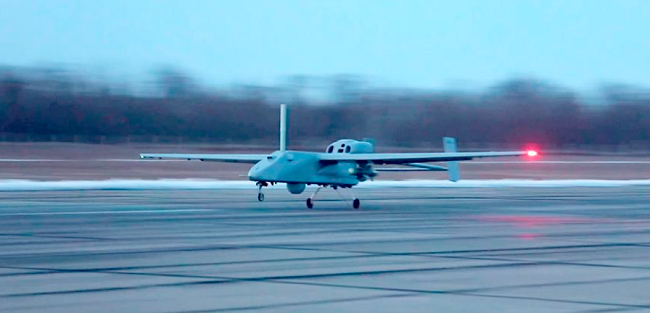
During the IDEX 2025 in Abu Dhabi, the Ural Civil Aviation Plant (UZGA), a major Russian manufacturer of unmanned aerial vehicles, announced the launch of a new version of the well-known FORPOST medium-altitude tactical reconnaissance drone, equipped with an integrated radar system.
It is very likely that the starting point for the modernisation was the latest version of the FORPOST-R drone, capable of carrying a payload of up to 100 kg. This load capacity allows the UAV to carry a small radar on board. It should be noted that the idea of integrating a radar on board a medium-altitude drone is not new.
In 2010, the Russian government commissioned Fazotron-NIIR to develop a small radar that could be installed on a UAV. The radar was renamed MF-2 KOGITOR, and was initially adapted for installation on the ORION drone. The radar was designed to carry out reconnaissance and surveillance missions. As a dual-band system, it consists of 2 modules, one front-facing (Ka band) and one side-facing (X band).
According to the manufacturer, the KOGITOR has the capacity to detect static and moving targets, both on land and on the water surface, as well as identifying and tracking aerial targets. The total weight of the system does not exceed 55-60 kg, which makes the KOGITOR ideal for installation on the FORPOST drone. The integrated radar should provide a variable range, depending on the task and weather conditions, from 0.2 to 28 km in the Ka band and up to 160 km in the X band.
In addition, it has been stated that the 2 radar modules can be installed and used separately; this has been made possible thanks to their very low weight. The Ka band module weighs only 23 kg and the larger X band module weighs just 35 kg.
The need to upgrade the FORPOST stems from increased losses of Russian helicopters over the Black Sea following the appearance of naval drones equipped with anti-aircraft systems in the Ukrainian Armed Forces. This new threat has forced the Russian Army to reconsider its anti-USV tactics and abandon the use of helicopters in favour of medium-altitude drones to search for and destroy targets. It was in this context that on 3 February 2025, an ORION drone detected and destroyed a Ukrainian naval drone in the Black Sea.








.png)
